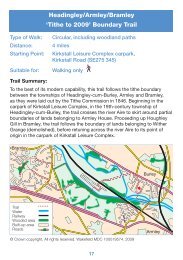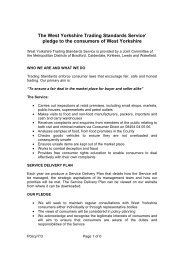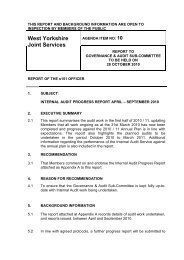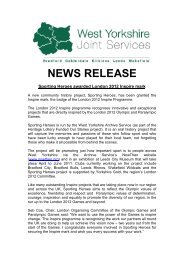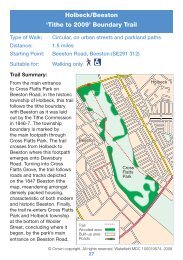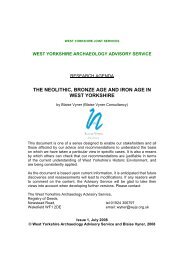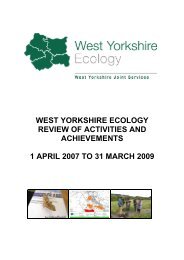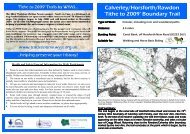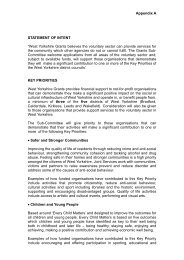hall tower hill, barwick in elmet - West Yorkshire Archaeology ...
hall tower hill, barwick in elmet - West Yorkshire Archaeology ...
hall tower hill, barwick in elmet - West Yorkshire Archaeology ...
You also want an ePaper? Increase the reach of your titles
YUMPU automatically turns print PDFs into web optimized ePapers that Google loves.
A tourist’s guide to <strong>in</strong>terest<strong>in</strong>g archaeological sites <strong>in</strong> <strong>West</strong> <strong>Yorkshire</strong>HALL TOWER HILL, BARWICK IN ELMETHall Tower Hill, Barwick <strong>in</strong> Elmet, is <strong>West</strong> <strong>Yorkshire</strong>’s largest motteHistoryIn the medieval period Barwick <strong>in</strong> Elmet formed part of the honour ofPontefract, a large group<strong>in</strong>g of manors given to Ilbert de Lacy after theNorman Conquest. In the 12 th century, Barwick became the regionaladm<strong>in</strong>istrative centre for the honour after Kippax ceased to fulfil the role. Thispossibly accounts for its relatively large size. Barwick may also have beendeveloped as a planned village at a similar time with dwell<strong>in</strong>gs along what isnow Leeds Road and crofts beh<strong>in</strong>d. It is not known when the castle wasf<strong>in</strong>ally abandoned but Rothwell took on Barwick’s adm<strong>in</strong>istrative functions <strong>in</strong>the 13 th or early 14 th century.The Rema<strong>in</strong>sAlthough parts of its ramparts are now obscured by modern developments,Barwick was once dom<strong>in</strong>ated by the earthworks of an Iron Age <strong>hill</strong> fort. Reus<strong>in</strong>gthis fortification for the erection of a castle was an obvious choice for thede Lacys: employ<strong>in</strong>g the exist<strong>in</strong>g defensive ditch cut down on time and labour.A similar tactic was also used when they built a castle at Almondbury.However the <strong>in</strong>ternal area of the <strong>hill</strong>fort was too large for the de Lacys’ needsand they lessened the area by creat<strong>in</strong>g what is now the street known as theBoyle. This divided the former <strong>hill</strong>fort <strong>in</strong>to two sections now known as WendelHill and Hall Tower Hill.
The motte is situated <strong>in</strong> the southern part of the enclosed space. It issurrounded by a ditch to separate it from the encircl<strong>in</strong>g bailey. The reusedramparts are clearly visible and a vantage po<strong>in</strong>t on the south western comerof the site allows the visitor to look over <strong>in</strong>to the defensive ditch below.No stone structures have been identified on the site so it is likely that themotte was topped by a wooden <strong>tower</strong> and that the rampart had a woodenpalisade. A recent geophysical survey failed to f<strong>in</strong>d any trace of build<strong>in</strong>gswith<strong>in</strong> the bailey but this may result from problems gett<strong>in</strong>g a clear signal fromthe underly<strong>in</strong>g geology rather than from the absence of any structures.An excavation <strong>in</strong> the early 1800s uncovered a number of skeletons but it isunclear what period they may have been from. Two Roman co<strong>in</strong>s have alsobeen found <strong>in</strong> the Barwick earthworks.Dur<strong>in</strong>g the Second World War the motte was used by the Royal ObserverCorps as an observation post. Its rema<strong>in</strong>s can still be seen on the top of themotte, where an <strong>in</strong>terpretation board is now situated.To see more of the Iron Age earthworks there is a footpath accessible fromthe Boyle which leads you across the centre of Wendel Hill and back to thevillage near the maypole.More <strong>in</strong>formation onthe WYAAS websiteEarthwork Castles <strong>in</strong> <strong>West</strong> <strong>Yorkshire</strong>: Part One Part TwoBarwick <strong>in</strong> Elmet Hillfort EarthworksBarwick Conservation AreaCartimanduaExternal l<strong>in</strong>kLocationAccessPastscape features detailed <strong>in</strong>formation on the site fromEnglish Heritage.Hall Tower Hill is situated on the western edge of the villageat SE 399 377. For map click here.The site is ma<strong>in</strong>ta<strong>in</strong>ed as a public amenity. Access isthrough a gate adjacent to a small chapel at the corner ofElmwood Lane. The bailey is fairly level band grassed over.There are steps to the top of the motte, but these can beslippery <strong>in</strong> wet weather. There are <strong>in</strong>formation boards on thesite.For more sites to visit go back to our Tourist Guide Ma<strong>in</strong>Menu.There is more <strong>in</strong> about Barwick and other archaeologicalsites <strong>in</strong> the Historic Environment Record which is housed <strong>in</strong>our Wakefield offices. For more <strong>in</strong>formation click hereThis guide was written by Dave Weldrake and is © WYAAS2010http://www.archaeology.wyjs.org.uk



